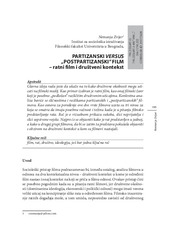| dc.creator | Zvijer, Nemanja | |
| dc.date.accessioned | 2022-03-22T13:20:10Z | |
| dc.date.available | 2022-03-22T13:20:10Z | |
| dc.date.issued | 2017 | |
| dc.identifier.issn | 1450-5681 | |
| dc.identifier.uri | http://reff.f.bg.ac.rs/handle/123456789/3551 | |
| dc.description.abstract | Glavna ideja rada jeste da ukaže na to kako društvene okolnosti mogu uticati na filmski medij. Kao primer izabran je ratni film, kao onaj filmski žanr koji je posebno „podložan” različitim društvenim uticajima. Konkretna analiza baviće se sličnostima i razlikama partizanskih i „postpartizanskih” filmova. Kao osnova za poređenje ove dve vrste filmova uzeta su tri nivoa za koja se smatra da imaju posebnu važnost i težinu kada je u pitanju filmsko predstavljanje rata. Reč je o vizuelnom prikazu sukoba, slici neprijatelja i slici sopstvene vojske. Najpre će se objasniti kako je rat predstavljen u jednoj, a kako u drugoj grupi filmova, da bi se zatim ta predstava pokušala objasniti
s obzirom na društveni kontekst u kom su filmovi nastajali. | sr |
| dc.description.abstract | The main idea of the paper is to point out how social circumstances can affect
on the film medium. As an example was chosen a war film, because that film
genre was particularly „subjected” to various social influences. Analysis dealt
with similarities and differences between Partisan films from the cinematography of socialist Yugoslavia and „Postpartisan” films from the 1990’s produced
in ex-Yugoslav countries. As a basis for comparing these two types of films,
three levels was choosen since they have special importance and weight when it
comes to showing the war on film. These levels are a visual display of the conflict, the image of the enemy and the image of one’s own army. Firstly, we explained how the war was presented in Partisan and „Postpartisan” films, and
then we try to explain that representation in light of the social context in which
the films were produced. Analysis showed crucial differences between Partisan
and „Postpartisan” films in one important acpect – the visual display of the
conflict. The monumental display of the conflicts in Partisan films directly corresponded to the ideological significance that the Second World War had for
Yugoslav communists. In contrast, the reduced and „unattractive” display of
war in „Postpartisan” films can be seen as a consequence of the huge economic
crisis that, along with the collapse of socialist Yugoslavia, captured the entire
post-Yugoslav space. Also, it should not be ignored the influence of the dominant ideology in which it was emphasized that „we” are the victims of external
aggression and that „ we” did not even participate in the war at all. Apart
from the difference, certain similarities between Partisan and „Postpartisan”
films were observed. Similarities are especially expressed in the representation
of enemies between Partisan and „Postpartisan” films from Croatia. It can be
said that the image of the enemies in Croatian films was largely influenced by
the Chetnik iconography that is characteristic of partisan films. Similarity with
Partisan films is also characteristic for „Postpartisan” films from Serbia, in the
affirmative representation of their own army. The most similarities between
Partisan and „Postpartisan” films can be seen in the maritrological patterns,
which is understandable because of the universalistic character of the figure of
the victim. | sr |
| dc.language.iso | sr | sr |
| dc.publisher | Institut za pozorište, film, radio i televiziju Fakulteta dramskih umetnosti u Beogradu | sr |
| dc.rights | openAccess | sr |
| dc.rights.uri | https://creativecommons.org/licenses/by-nc/4.0/ | |
| dc.source | Zbormik radova Fakulteta dramskih umetnosti | sr |
| dc.subject | film | sr |
| dc.subject | rat | sr |
| dc.subject | društvo | sr |
| dc.subject | ideologija | sr |
| dc.subject | Jugoslavija | sr |
| dc.subject | war | sr |
| dc.subject | society | sr |
| dc.subject | ideology | sr |
| dc.subject | „Postpartisan” film | sr |
| dc.title | Partizanski versus "postpartizanski" film | sr |
| dc.type | article | sr |
| dc.rights.license | BY-NC | sr |
| dc.citation.epage | 209 | |
| dc.citation.issue | 32 | |
| dc.citation.rank | M52 | |
| dc.citation.spage | 195 | |
| dc.identifier.fulltext | http://reff.f.bg.ac.rs/bitstream/id/8113/bitstream_8113.pdf | |
| dc.identifier.rcub | https://hdl.handle.net/21.15107/rcub_reff_3551 | |
| dc.type.version | publishedVersion | sr |

